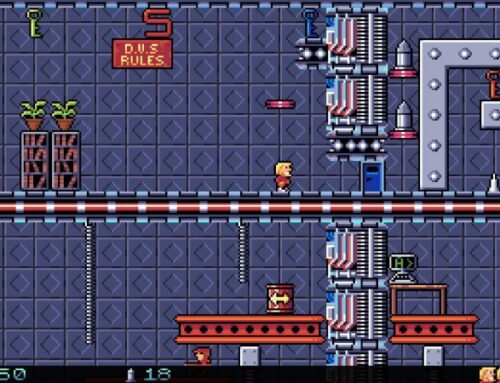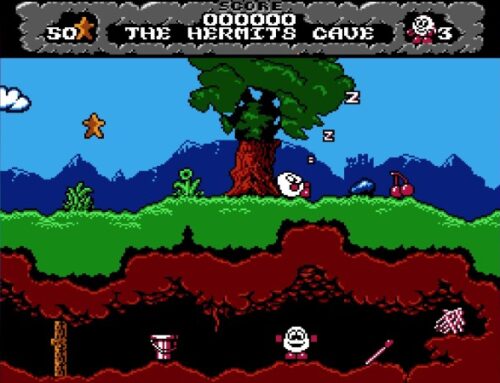Namco put out some amazing games in the PS1 era, of which Ridge Racer is, of course, their most famous. But Star Ixiom is one that most people slept on at the time — and it’s a grand old time well worth your attention.
Let’s take a moment to rewind and catch up first. Star Luster is a space combat game by Namco, originally released for Famicom in 1985. Despite it being an obvious homage to an incredibly popular Western game — Atari’s Star Raiders — it never came West.
35 years later, Star Luster finally got a worldwide release as part of the Namco Museum Collection 1 cartridge for Blaze’s Evercade retro gaming system. This was my first contact with a game that I ended up absolutely loving — and after looking into it further, I was surprised to discover it got a sequel for PlayStation in 1999. A sequel which got a fairly middling reception because the press of the time compared it unfavourably to its rough contemporary Colony Wars — and, of course, because relatively few people in the West had any clue that Star Luster existed.

37 years after the release of Star Luster and 23 years after the release of its sequel, we now contemplate that sequel: Star Ixiom. So let’s take a look at what this space-based blastathon has to offer — and how well it holds up today.
Before that, though, a quick note for fans of obscure Namco lore that doesn’t matter but is fun to bore people at parties with: both Star Luster and Star Ixiom unfold as part of Namco’s “United Galaxy Space Force” universe, which also includes Galaxian, Galaga, StarBlade, Bosconian, Burning Force, Ace Combat 3: Electrosphere, Dig Dug and Mr Driller. Yes, really.
Unfolding some time after Star Luster, in Star Ixiom, you take on the role of Roy Heinik (presumably a descendant or other relative of Dan Heinick [sic] from Star Luster) as he learns how to fight in a galaxy at war, works his way through a series of missions and finally takes sole responsibility for eradicating the alien invaders that have driven humanity from their home planet.

The game is structured quite similarly to Star Luster, right down to having three different game modes. They’re implemented slightly differently here, though: Training mode once again offers a small-scale battle with little to no real threat, providing you an opportunity to get used to the controls, but this time around Command mode takes you through a linear sequence of relatively small-scale missions that get increasingly strategic as you progress, while the Conquest mode presents you with a large-scale quasi-strategic game where you’re largely left to your own devices.
In each of the three modes, there are several different modes of interaction with the game. There’s the galaxy map, which presents a grid representing the sectors you’re defending, along with enemy positions, friendly bases and planets. There’s the in-cockpit view, which is where the main action of the game unfolds. And a significant addition over Star Luster is the fact that in Star Ixiom you can actually land at bases, get out of your ship and wander around in glorious PS1-era polygonal-characters-on-pre-rendered-backdrops-o-vision.
In Command mode, each mission starts with you directly in front of a base so you can immediately dock, and in Conquest mode you start your story already on a base. While you’re docked, you can wander around four different areas: the docking bay for your ship, a main concourse, a lounge and the base’s main command centre. In each of these locations, you can chat with various NPCs, most of whom have a few tips to offer, but a couple of the locations have more useful functionality available.

In the command centre, for example, you can take a look at the overall map of your current mission without time passing, allowing you to devise a suitable plan of attack. You can also review information for all the different types of enemies you’ve encountered so far — more on those in a little while.
In the docking bay, meanwhile, speaking to the engineer on duty allows you to select from any of the available spacecraft — which include ships from Star Luster, Galaxian and StarBlade, each of which have their own unique cockpit and handling characteristics — and equip it with both a subweapon and a piece of optional equipment. Subweapons are powerful armaments that either consume your ship’s energy for stronger shots or have limited ammunition, while optional equipment tends to provide some sort of helpful passive ability such as wider radar range, decreased damage taken or the ability to damage foes by proximity.
There are some cool visual touches in the base scenes, the neatest of which is the fact that when you change your selected ship in the docking bay, you see the new one being moved into position for you beneath the gantry you’re standing on. It’s the little things.

Once you launch into space, you’ll want to make use of the map to pick a target and head in its direction. Like in Star Luster, this involves picking a sector and then using hyperspace to get there relatively quickly, consuming a certain amount of energy and time in the process. The hyperspace sequences in Star Ixiom are accompanied by some gloriously ’90s kaleidoscopic visual effects that just about make up for the fact that your ship’s ambience no longer sounds like a Philips G7000 booting up. 14 years passed between the two games, after all.
In combat, you’ll notice some immediate improvements over Star Luster. Firstly, the use of polygonal 3D graphics for the enemies provides a much greater sense of scale, depth and overall position — especially apparent in some stages where you fight large capital ships. Secondly, the implementation of the radar now indicates whether foes are above or below you — a common bugbear for new Star Luster pilots — which makes it a lot more practical to use. And thirdly, the whole thing just looks lovely — there are plenty of colourful backgrounds, featuring vibrantly coloured nebulae, nearby planets and even burning stars. There’s plenty of variety.
And there’s plenty of variety in the enemies, too. Not only will you face the “Battura” foes from the original Star Luster — now in full 3D, and displaying pleasingly similar behaviours to their 2D counterparts — you’ll also come up against an original new race, plus foes from Bosconian, StarBlade… and Galaga. Yes, in Star Ixiom you have the opportunity to blast space bugs in first person, accompanied by a gloriously orchestrated version of Galaga’s iconic music and satisfying “screech” sounds any time you splatter them.

The different enemy types all display different behaviours and have different means of attacking you, meaning you’ll need to get used to their capabilities as you progress through the game. Since enemy squadrons typically include a variety of different craft within the same “type”, you’ll often have to prioritise your targets to figure out which are the biggest threats rather than just blasting away at whoever is closest — this becomes particularly important in the Conquest mode, where you end up having to think about a lot of things at the same time.
Speaking of the Conquest mode, there are a few additional mechanics at play that distinguish it from Star Luster’s Adventure mode. Most notably, Conquest mode adds friendly Laboratory installations around the galaxy, which gradually research new technology for you over time, allowing you to equip your ship with more and more advanced subweapons and optional units the longer you survive. This gives a nice sense of progression to the game, and a strong contrast from the mission-based Command mode.
If this all sounds like there’s a surprising amount of strategy in there as well as enjoyably straightforward blasting action, you’d be right. Star Ixiom was designed from the ground up to blend elements of tactical role-playing games and space combat games, and was marketed as a “simulation and shooting” game in Japan to reflect this combination of genres.
Don’t be discouraged if you’re not normally a particularly strategic gamer, however; the game is highly accessible, consisting primarily of arcadey space shooting with simple controls, and the gradually increasing complexity of the missions in Command mode is clearly designed to train you in the various ways you might want to approach the rather more open Conquest variant. Take your time to enjoy the game to the fullest and there’s a really nice difficulty and complexity curve to appreciate, with plenty of gameplay depth on offer when you’re good and ready for it.

It’s probably worth addressing the press of 2000’s unfavourable comparisons of Star Ixiom to Colony Wars at this point, since the latter is regarded by many as the benchmark for space flight sims on PlayStation while Star Ixiom remains relatively unknown.
The fact is, Star Ixiom and Colony Wars are very different games. Colony Wars takes a highly cinematic approach — likely inspired by the success of classic PC series Wing Commander and X-Wing — and focuses on its unfolding, branching narrative.
Star Ixiom, meanwhile, is a mechanics-centric game that uses the mission-based Command mode to build up the player’s confidence before setting them loose in the main attraction: the challenging Conquest mode. Despite superficial similarities — they both unfold primarily as first-person spaceship shooters with a full six degrees of freedom — they’re really not directly comparable at all due to their vastly different structure and obvious design intentions.
It’s unfortunate that the game’s reception turned out this way, because Star Ixiom is a really solid addition to Namco’s already excellent PlayStation lineup that sadly went overlooked and underappreciated back in the day. Now that its predecessor Star Luster is more readily available to a Western audience — and has proven itself to be a big hit among people who never played it back in the day — I’d say Star Ixiom is definitely worth revisiting, too. It’s a solid, satisfying space blaster with deep yet accessible gameplay, a great soundtrack and a ton of subtle Namco fanservice to enjoy.
Just one question it leaves us with: why isn’t it called spAce Combat?




